Highlights
Hugging the slopes that rise steeply from the waterfront, St Peter Port creates a spectacular vista as you arrive by sea. Church steeples and tiers of granite houses are stacked on the hillside, while in the harbour below the forest of boat masts jostle for attention, lending the capital an almost Mediterranean air.
This is the oldest community in the Channel Islands, and it shows. The discovery of a Roman wreck in the harbour in 1985 indicated that this part of Guernsey’s coastline was a refuge for seamen even in ancient times. The Town Church existed as early as 1048 and a castle has stood here since 1206, though today’s town is made up mainly of finely-preserved late Georgian and Regency buildings.
From the 12th to the 16th centuries fishing was the main activity and St Peter Port was merely a small quayside settlement. It was through privateering that the town grew in size and wealth. In 1778 alone, local privateers brought in £343,500 of booty. Wealthy merchants built fine houses and new buildings spread up the slopes around the town and onto the plateau above. The granite houses appear piled on top of one another. The seafront Esplanades are lined by tall and unadorned warehouses, most now converted to shops, pubs and restaurants. The grander houses of 18th-century merchants, on the hilltop above, have also undergone conversion – some of the fine houses along Grange Road and The Queen’s Road now belong to wealthy banks and financial organisations, but their conversion has been carried out with sympathy for the original buildings.
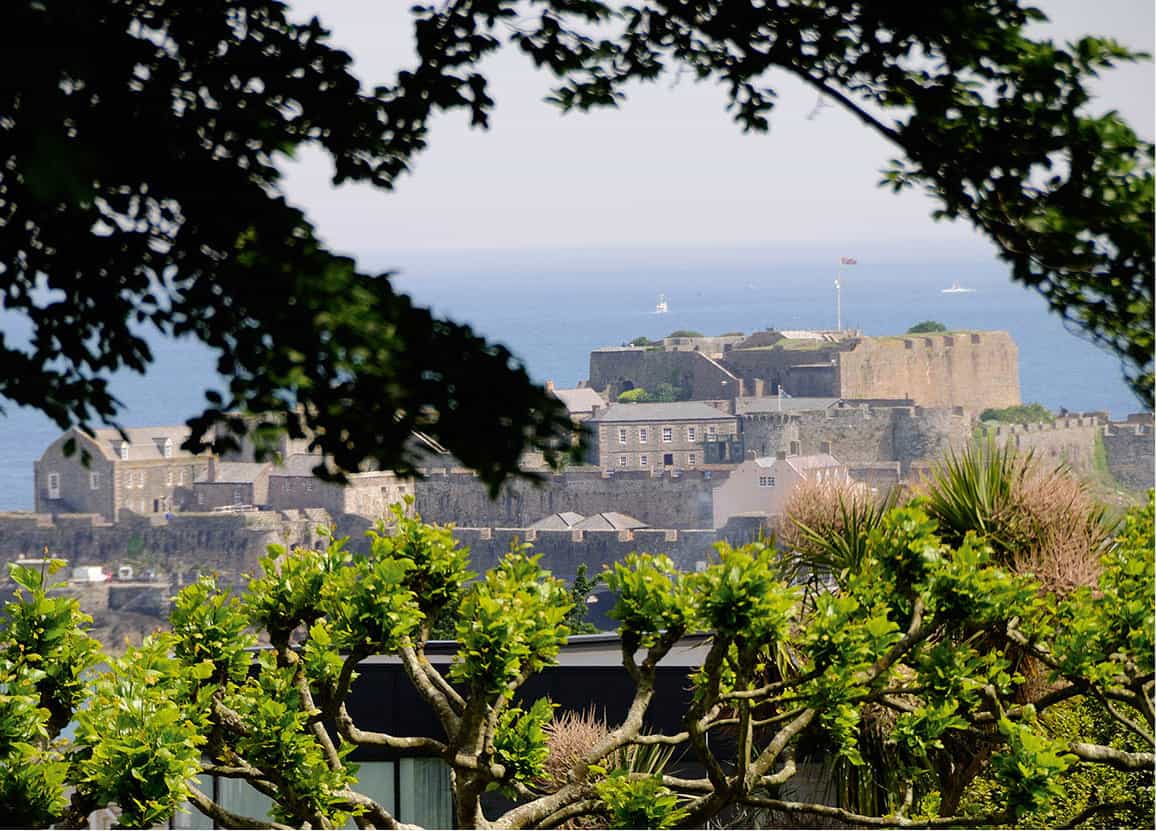
View from St Peter Port across to Castle Cornet.
Mockford & Bonetti/Apa Publications
The Waterfront
A good place to begin exploring the town is the excellent Guernsey Information Centre 1 [map] (tel: 01481-723 552; www.visitguernsey.com; Mon–Sat 9am–5pm, Sun 10am–1pm), on North Esplanade, with its informative displays and helpful staff. The centre is housed in a building of 1911, whose grey granite makes it look rather austere – perhaps deliberately so, as this was once Guernsey’s administrative centre, where all the departments needed to run the island were based. The information centre sits on land that was reclaimed at the beginning of the 20th century.
From April to September, accredited guides offer a rota of interesting guided walks on a daily basis, some departing from the Information Centre in St Peter Port (tel: 01481-723 552; www.guernseyguidedtours.com). During the annual Spring and Autumn Walking Weeks, an extensive programme on the island includes history, flora and fauna.

Walking down the Constitution Steps in St Peter Port.
Mockford & Bonetti/Apa Publications
Originally ships docked right alongside the warehouses that line Quayside. This allowed cargoes of wine, citrus fruits, spices, sugar and wool to be lifted straight from the ship’s hold into the tall Dutch-style warehouses, whose large loading doors have been replaced by windows. Most of them are four or five storeys tall, with one set of shops on the lower two floors, entered from Quayside, and another set of shops on the upper floors entered from the High Street. Linking Quayside and the High Street are a number of steep lanes, called venelles (Guernsey-French dialect for ‘little passages’). Look up as you explore them – some have roofs made of massive timbers from broken-up ships.

The harbour of St Peter Port is still an active port for local fishermen, who provide the freshest catch to local restaurants.
Mockford & Bonetti/Apa Publications
The harbour
On the opposite side of Quayside is the harbour 2 [map], with a mixture of yachts, cargo ships and inter-island ferries. With the advent of the steamship service between Guernsey and England, new facilities were called for; in 1853 the harbour area grew from 4 acres (1.6 hectares) to over 80 acres (32 hectares), with two long breakwaters installed 13 years later. Albert Pier and North Pier enclose the Old Harbour, where yachts are moored in the marinas.
Profiting from piracy
From the late 18th century, St Peter Port prospered from the practice of privateering. This was a form of legal piracy whereby ships were licensed by the British Government to capture enemy vessels and confiscate their cargoes. As England imposed duty on imported luxury goods as a means of funding its wars with France, Spain and the American colonies, Guernsey became a major supplier in the smuggling trade, shipping large quantities of captured brandy, perfume and lace to England.

Guernsey’s proximity to France made it an ideal hideaway for pirates.
Mockford & Bonetti/Apa Publications
The less picturesque St Julian’s Pier to the north was added in the 1920s to make way for cargo ships and ferries. Today, high-speed catamarans sail for mainland Britain and France. At the landward end of the pier you’re unlikely to miss the Travel Trident booth selling tickets for ferries to Herm, the diminutive car-free island which you can see in the distance. Further along the pier you can purchase tickets for Sark, another popular day trip island, one stop further to the southeast.

The Liberation Monument was designed by Guernsey artist Eric Snell.
Mockford & Bonetti/Apa Publications
Liberation Place
Close to the Travel Trident booking kiosk, the Liberation Monument 3 [map], a granite ‘needle’, commemorates the liberation of Guernsey from Occupying German forces on 9 May 1945. It was here that crowds of islanders greeted the British liberators after five years under German rule. On Liberation Day each year, and only on this day, the monument casts a shadow onto the plaques on the adjacent granite bench, each marking a key event of that jubilant day. The monument is designed so that the tip of the shadow reaches each commemorative plaque at the precise time of the event it commemorates.
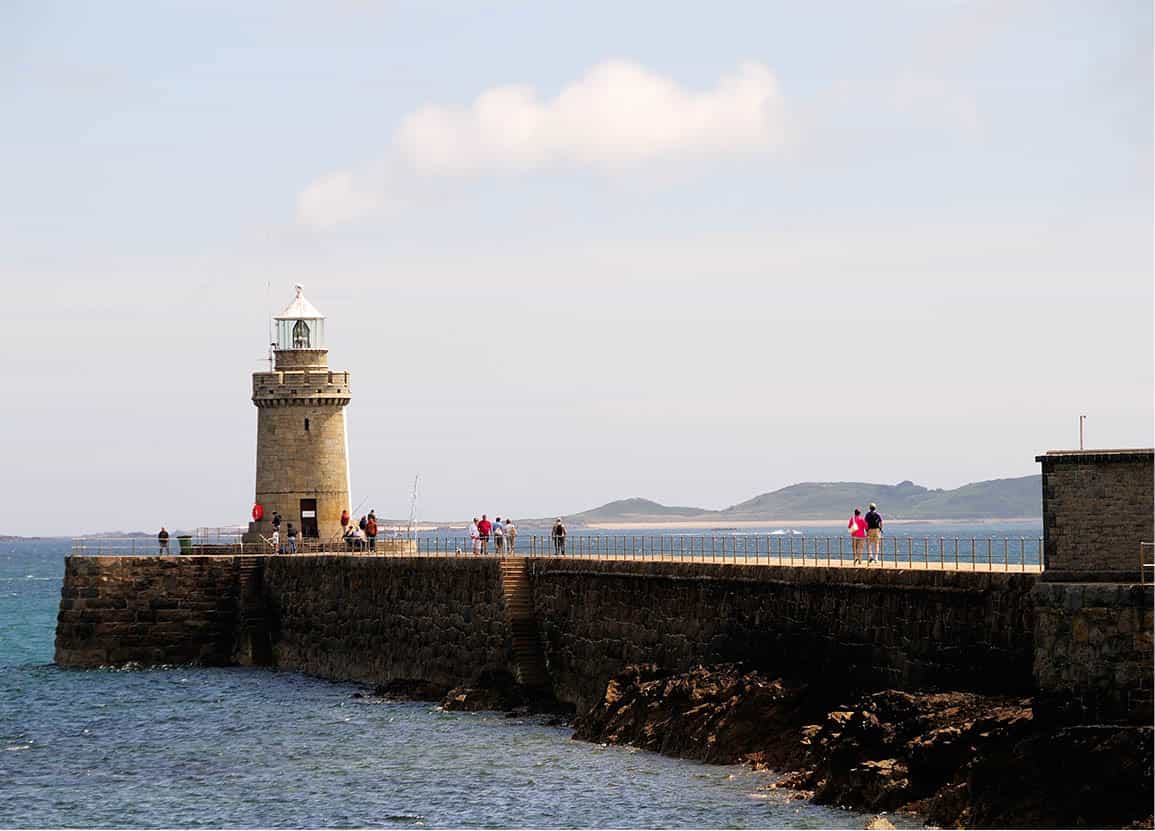
Sweeping views from the breakwater.
Mockford & Bonetti/Apa Publications
The Town Church
Heading south, you will come to St Peter Port’s busiest road junction, overlooked by a statue of Prince Albert, erected to commemorate a visit made by Queen Victoria and Prince Albertin 1846. Opposite is the parish church of St Peter Port, or the Town Church 4 [map], whose sturdy steeple rises above the waterfront. Although it incorporates the nave of the town’s earlier medieval church, much of the original fabric was damaged during the Civil War and the building underwent major restoration in the 19th century. One of the war’s ironies was that the town, and the castle that was intended to protect it, were on opposite sides in the conflict. St Peter Port sided with the Parliamentarians, whilst the governor of Guernsey supported the Royalist cause and successfully survived a nine-year siege from his base in Castle Cornet. The Royalists bombarded the town with such success that shipping was forced to move to St Sampson’s harbour, further up the coast. Note how close the Albion House Tavern is to the church, almost within touching distance. This is the closest inn to a church in the British Isles.

The bell tower of Town Church decorated with hanging baskets.
Mockford & Bonetti/Apa Publications

Looking down on Sutler’s Garden at Castle Corne.
Mockford & Bonetti/Apa Publications
Castle Cornet
Built to protect the settlement in the 13th century, Guernsey’s castle was formerly isolated on a rocky islet, and accessible only by boat. A breakwater and bridge were built in the 19th century and today’s visitors explore the castle by walking out along the Victorian Castle Pier. (Be sure to get the right pier; from the Esplanade you can be fooled into thinking the castle lies at the end of the shorter Albert Pier.) A great breakwater stretches beyond the castle, with a lighthouse at the far end where optimistic anglers cast their lines. A third of the way along the pier you can divert left to Fish Quay, where the workaday fishing boats land their catch and gulls swoop down in the hope of tasty morsels. The fruits of the fishermen’s labour, including live lobsters, can be seen and bought at Seafresh fishmonger on the pier. Continue along the pier to Castle Cornet 5 [map] (www.museums.gov.gg; Apr–Oct daily 10am–5pm, July–Aug daily 9.30am–5pm, guided tours daily at 10.30am; charge), enjoying fine views of Havelet Bay and the town skyline. Shielding the entrance of St Peter Port harbour, this major monument is a delightful maze of buildings and courtyards, linked by steps and passageways, with little gardens tucked into sheltered corners. The castle was a stronghold of the English Crown for nearly 800 years, and now several buildings within the grounds have been converted into museums. Allow plenty of time if you want to see it all; try to time a visit to coincide with the noon-day gun ceremony, when two redcoats fire an artillery salute to St Peter Port. Beware the sudden roar!
Castle entertainment
From Easter to the end of September the Guernsey History in Action Company (www.ghiac.org) re-enacts stories from Guernsey’s past, from Tudor times to the German Occupation. Performances last 20–30 minutes and take place daily, usually just after noon, in the castle grounds. In July and August, the castle is the setting for theatre productions. Look out, too, for Castle Nights, offering free evenings of music and live entertainment from 6pm.

Historical performers provide summer entertainment at the castle.
Visit Guernsey
The oldest part of the castle survives only in fragmentary form – the original keep and most of the medieval buildings were destroyed when the castle magazine was struck by lightning on 29 December 1672, killing the governor’s wife and mother, and five other people. Displays show the results of archaeological excavation to recover the form of the original medieval castle, while the present fortress is substantially Tudor in date. It was the first English-built castle to incorporate ideas borrowed from Italy – thicker masonry to absorb cannon fire, as few vertical faces as possible (oblique and rounded faces were better at deflecting cannon balls) and bastions projecting at intervals along the curtain wall to provide gun platforms and protect from a direct attack.
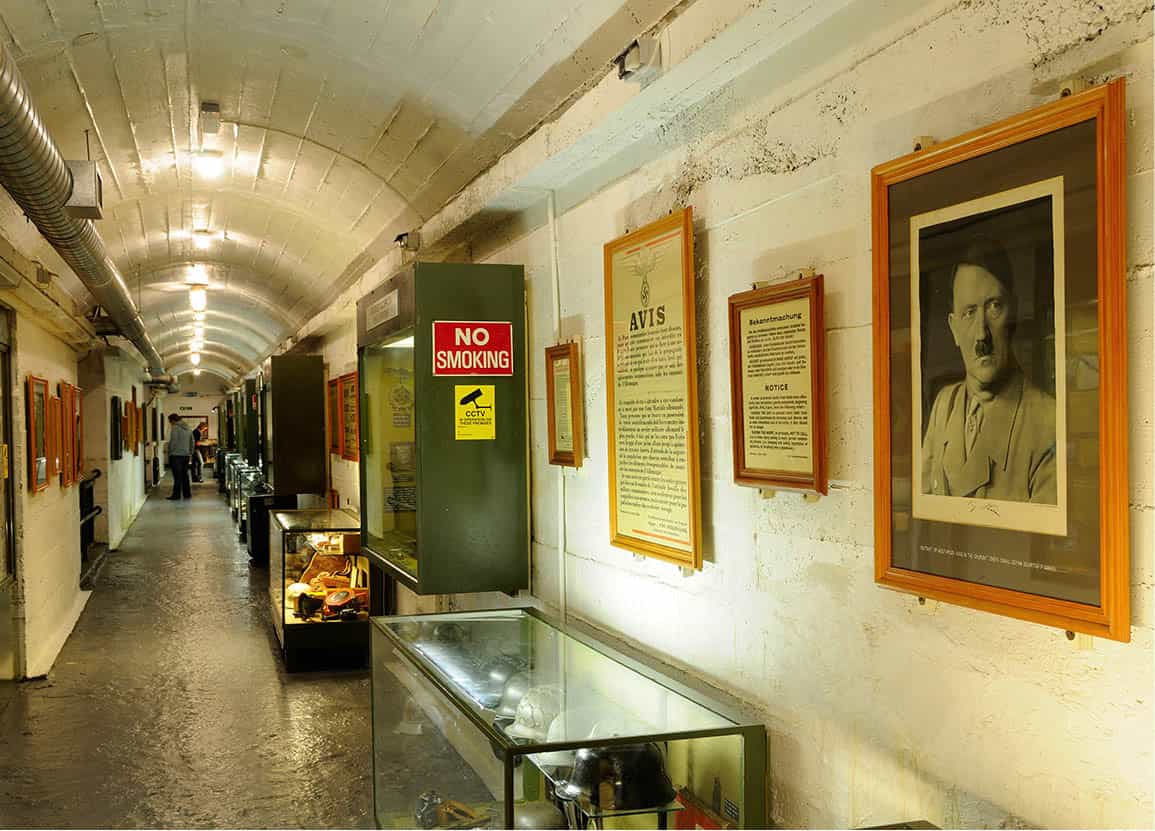
The Underground Military Museum’s collection of artefacts.
Mockford & Bonetti/Apa Publications
The success of this design was proved during the Civil War siege, when the castle was all but impregnable, and again when, during World War II, the Germans occupied the castle and found that they had to make very few modifications to fit it for modern warfare.
The castle contains a number of interesting museums. The Story of Castle Cornet Museum, housed in the Lower Barracks (opposite the ticket office) traces 700 years of turbulent history. The absorbing Maritime Museum in the Upper Barracks building starts with prehistoric trade, when stone axes were bartered for grain and fish, and ends with the modern era of high-speed catamarans. One section is devoted to Asterix, a Gallo-Roman wreck which came to grief in AD286 in the mouth of the harbour. A video tells of its discovery and salvage in 1982. Maritime exhibits include colourful ships’ figureheads, privateer licences and Victor Hugo’s personal lifebelt and lifejacket – the writer was deeply interested in the question of safety at sea and commissioned his own special safety equipment.

Cannons defended the walls of Castle Cornet from invaders.
Mockford & Bonetti/Apa Publications
The 201 Squadron Museum covers ‘Guernsey’s Own’ RAF air heroes. In the 18th-century hospital buildings, the Royal Guernsey Militia Museum depicts the tragic story of the death of the Royal Guernsey Light Infantry in spring 1917; and the Royal Guernsey Light Infantry Regimental Museum tells the story of the regiment, which was formed during World War 1 and served in France.
A Discovery Pass, available from Guernsey Museum at Candie, Castle Cornet, Guernsey Information Centre, the German Naval Signals HQ, Guernsey Pearl and Beau Sejour Leisure Centre, allows 12 months’ unlimited entry to Castle Cornet, the Guernsey Museum, Fort Grey and the German Naval Signals HQ, with accompanying children going free.
Occupation tours
The Channel Islands were the only British territory to fall into German hands during World War II. The islands of Guernsey and Jersey were invaded in June 1940 and turned into fortresses. In May 1945, after five long years, British forces liberated the islands. For information on German Occupation tours, ask at the tourist information office in St Peter Port.

Art from the Occupation at the Guernsey Museum.
Mockford & Bonetti/Apa Publications
La Vallette Underground Military Museum
Continuing along South Esplanade you will come to the town’s main bathing beach, to your left (sandy at low tide), before reaching the green end of St Peter Port, where gardens and trees cloak the steep hill above the undercliff footpath. Continue along here for a short way and you will soon reach La Vallette Underground Military Museum 6 [map] (www.lavalette.tk; Mar–mid-Nov daily 10am–5pm; charge). The simple concrete-lined opening in the cliff leads into a complex of tunnels built by slave labourers during the Occupation. Whips and rubber truncheons displayed in the museum bring home the brutal nature of their treatment. The tunnels served as a refuelling station for U-boats, and one of the huge fuel oil storage tanks has survived.
Posters relating to the final difficult months of the war detail arrangements for the evacuation of the islands in 1940, when it was clear that the Germans intended to invade. What was not clear, as the posters show, was whether or not the British government intended to send an evacuation ship to rescue those islanders who wished to leave. In the end, 9,000 people – more than half the islands’ population – managed to escape in fishing boats and cargo steamers, including almost the entire population of Alderney. Among all the fascinating military and civilian memorabilia is a display of Red Cross food parcels delivered by the Swedish ship, the Vega, towards the end of the war, when the population of the Channel Islands was close to starving. To people used to surviving on a meagre diet of seaweed jelly, bramble-leaf tea and parsnip-root coffee, the food parcels, filled with milk, cheese, butter, chocolate, oatmeal and peas, would have come as much-needed relief.
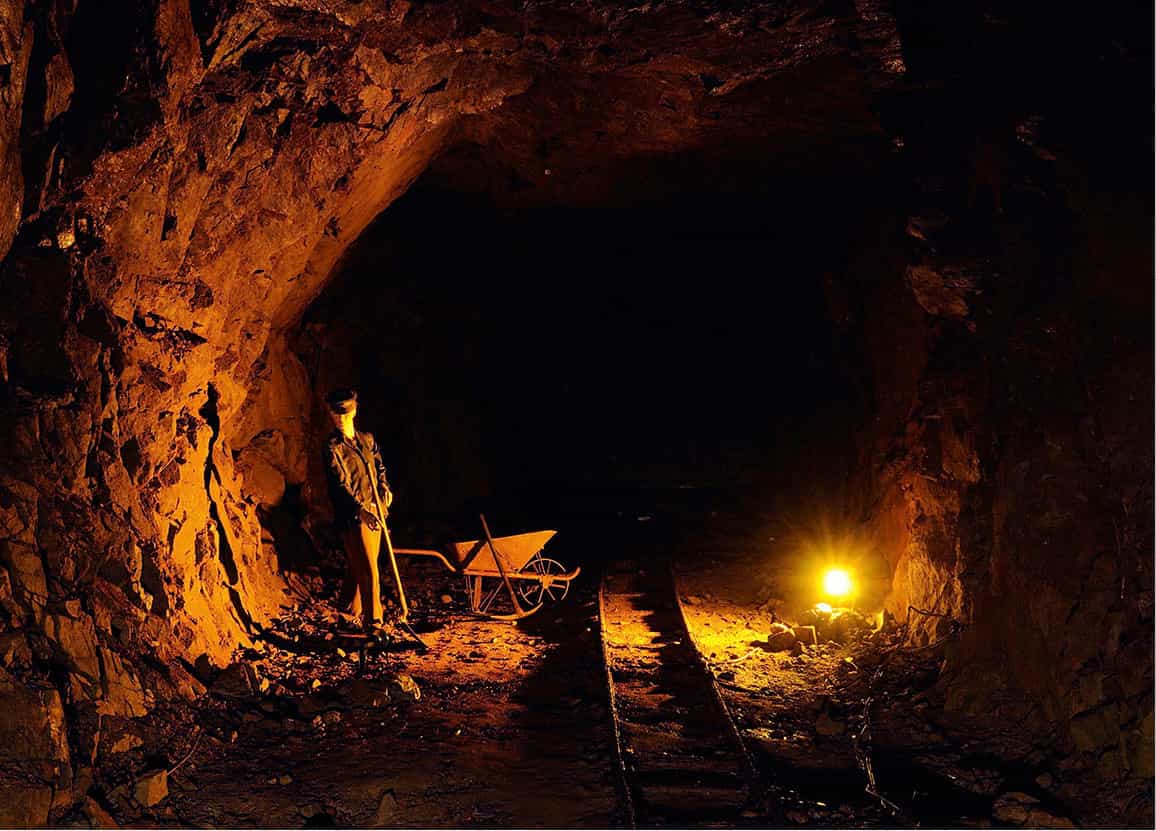
One of the tunnels at the Underground Military Museum.
Mockford & Bonetti/Apa Publications
VAT-free shopping
In theory, shopping in the Channel Islands ought to be cheap because there is no VAT to pay on purchases and because import duties are low. In reality, the cost of freighting goods to the islands often cancels out the gains. Before purchasing jewellery, cameras and electronic goods you should do your research and have a good idea how much the same item would cost back home.
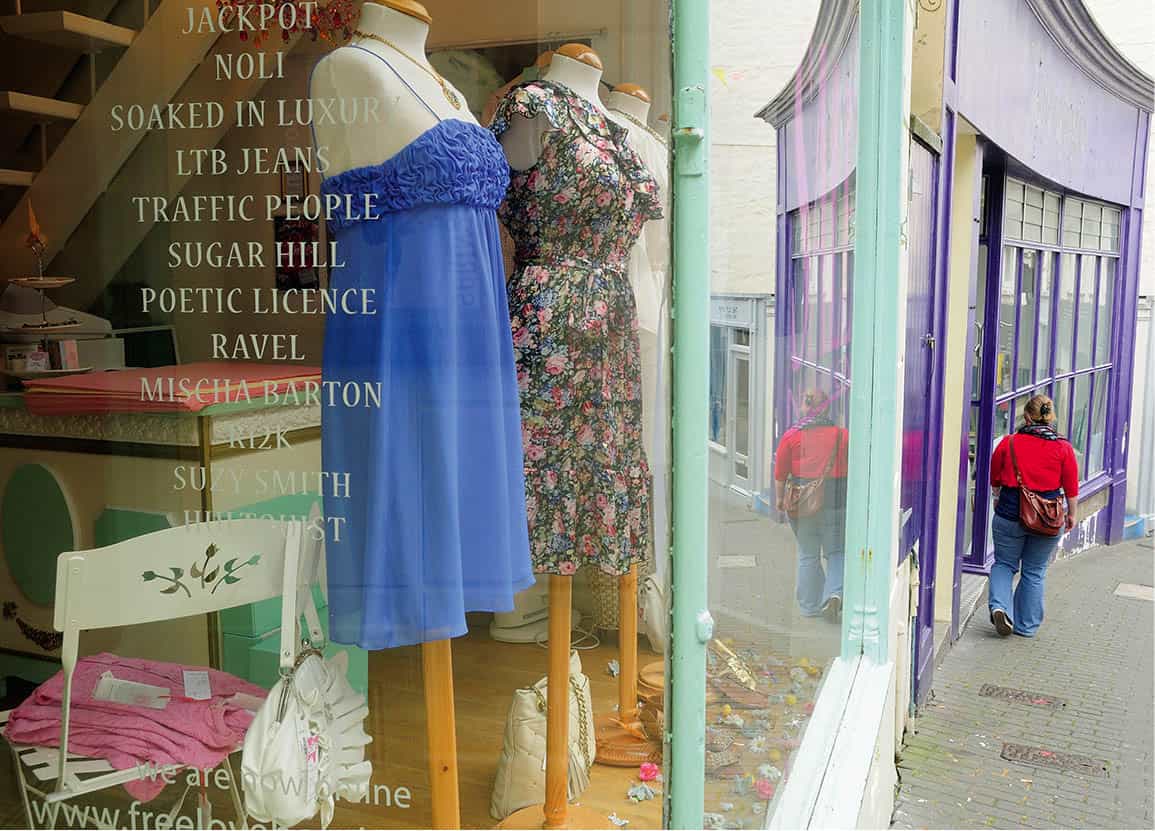
Boutique shopping on Mansell Street, Old Town.
Mockford & Bonetti/Apa Publications
Another exhibit reminds us that most of the islands’ fortifications were constructed by forced labour. The people were protected from exploitation, to a degree, by the Hague Convention, which the Germans observed, stating that local people could not be forced to construct works of military character, especially against their own country. Even so, there were reprisals against the civilian population, including the confiscation of radio sets, and executions for acts of so-called espionage. Others were interned in Biberach Camp, in Bavaria, from September 1942 until May 1945, and there are some moving exhibits of Christmas gifts and cards made by the internees and sent back to their families.
La Vallette Bathing Pools
Across the road from La Valette Underground Military Museum, the seafront promenade affords fine views of Castle Cornet and neighbouring islands. At low tide you can spot La Vallette Bathing Pools, public swimming pools since Victorian times. The first was the Horseshoe, built in 1859 with a small dressing room, then the Ladies and Gents were added in the 1870s and the Children’s pool in 1896. Today all four pools – when they are not submerged by the tides – are open to all, free of charge. This is where The Guernsey Swimming Club holds the annual Polar Bear Swim on Christmas Day.
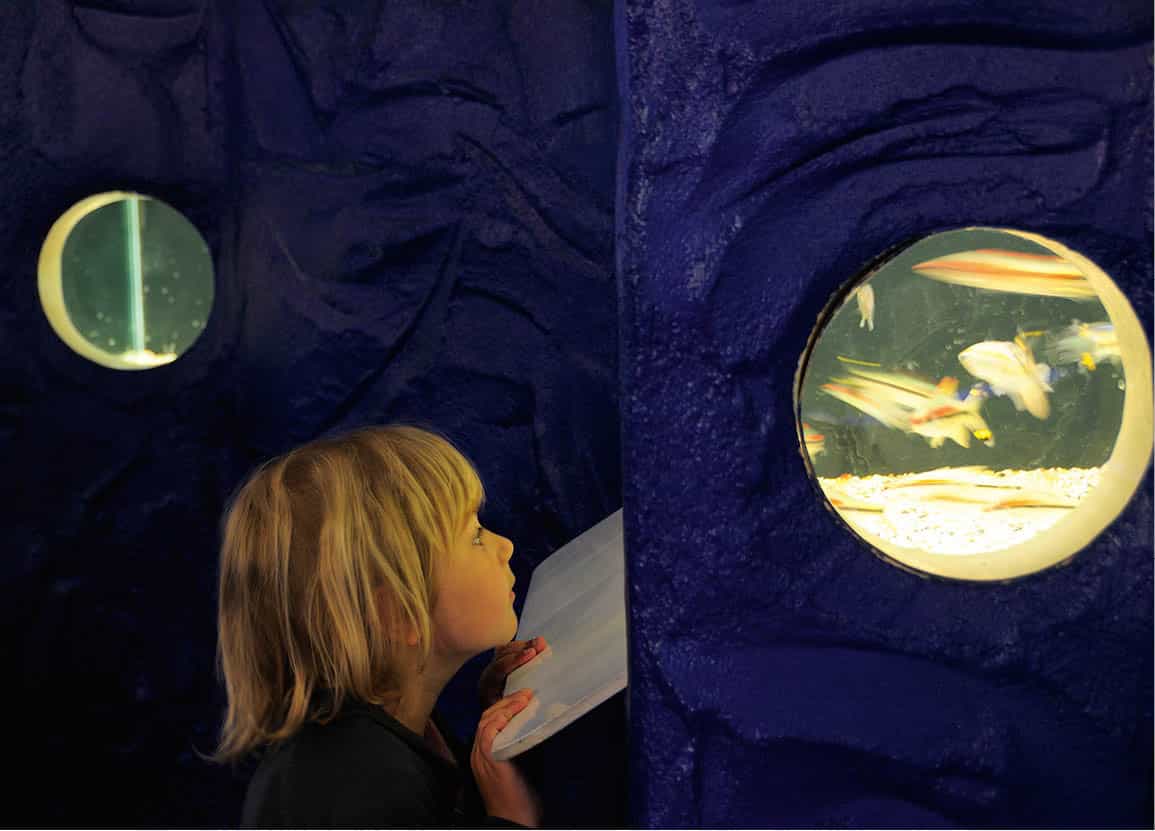
There are multiple displays of marine life at the Guernsey Aquarium.
Mockford & Bonetti/Apa Publications
The Aquarium
The South Esplanade continues a short way to another tunnel: this one was built in 1861, as part of a scheme, for building a road through to Fermain Bay (for more information, click here). The Germans constructed several side tunnels using Russian labourers, who left their hammer and sickle symbol on the rocky roof.
Today the tunnels house the Aquarium 7 [map] (tel: 01481-723 301; daily 9am–5pm; charge), displaying examples of the many and varied fish to be found in Guernsey’s waters – from perfectly camouflaged baby soles and the tiny inhabitants of tidal pools, to larger conger eels and dogfish. There are also prettily patterned tropical fish, with notes on their habitats and suitability for use in home aquariums, a collection of reptiles in a vivarium and a tank containing locally-rescued terrapins.

An indigenous lobster at the Guernsey Aquarium.
Mockford & Bonetti/Apa Publications
The high town
Returning to Castle Pier, the causeway that leads out to Castle Cornet, climb up the steep lanes on the left that lead past the Yacht Inn, turn left to the cobbled intersection of four alleys, then right up Coupée Lane. You should come out alongside the Victorian Shop and Parlour at No. 26 Cornet Street 8 [map] (April–Sept Tue–Sat 10am–4pm, free) a remarkable building that serves as the headquarters of the National Trust of Guernsey. The offices lie behind the well-restored 18th-century shop and parlour, where volunteers in period costume sell gift and souvenirs, as well as sweets, which are measured in pounds and ounces.
Turn left out of the shop and you will pass, on the right, the former church of St Barnabas, the home of the Island Archives; from the car park there is a superb view over the red-tiled rooftops of Guernsey. Further along, Tower Hill Steps, with its pubs and restaurants, has a pleasing group of late Georgian and Regency buildings and beyond, on the right, lies Pedvin Street, with a long curving terrace of late Georgian houses.

Hauteville House was personally decorated by Victor Hugo.
Visit Guernsey
Continue left here into Hauteville, a street where the increasingly large and ornamented houses and villas give some indication of the status and wealth of the people who first settled here, when the area began to be developed in the 1780s.
Hauteville House
The street’s most famous resident was Victor Hugo, the great French romantic poet, writer and politician. In 1856 he bought No. 38, Hauteville House 9 [map] (April–Sept open daily except Weds 10am–4pm; tel: 01481-721 911; www.victorhugo.gg; guided tours only, charge except for garden), where he lived for 15 years. The house, which underwent a full renovation in 2019, is beautifully preserved and the gardens brought back to their original splendour. Hugo was more than a little eccentric, and the house is a physical manifestation of his quirky ideas about monarchy, history and patriarchy.
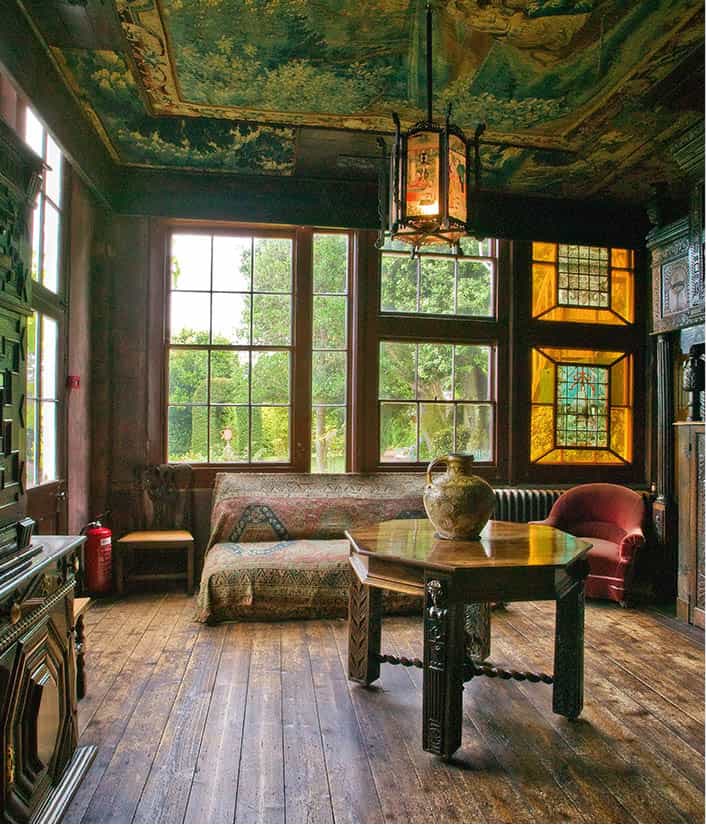
Victor Hugo lived at Hauteville House for 15 years.
Visit Guernsey
Having been thrown out of France, branded as a dangerous radical for his opposition to the coup d’état staged by Prince Louis Napoléon in 1851, Hugo first settled in Jersey, where he kept up a tirade against ‘Napoléon le petit’ as he styled the French emperor, through his newspaper L’Homme. In the same paper, he criticised Queen Victoria for making a state visit to Paris in 1855. This so angered the people of Jersey that Hugo was expelled once again – this time moving a short distance north to the island of Guernsey. Here he installed his wife (‘Madame, la mère de mes enfants’) and family at Hauteville House, and Juliette Drouet, his mistress (‘Madame, mon amie’), at No. 20 Hauteville, which had been his first Guernsey home. This was sufficiently close for Hugo to signal to his mistress from his bedroom window.
Forever French
Despite living in the Channel Islands for 18 years, and feeling at home here, Victor Hugo never learned to speak English. ‘When England wants to chat with me, let her learn my language’ he said. His heart always belonged to France, and one of the reasons he chose the Channel Islands when he was exiled from France was that his native language was understood.
Whilst living here he wrote some of his best-selling novels, including Les Misérables and Les Travailleurs de la Mer (The Toilers of the Sea) which is set in and around Guernsey and demonstrates Hugo’s intimate knowledge of the island. Growing wealthy for the first time, Hugo indulged his taste for woodworking and interior decoration. Thanks to the anti-Church zeal and anarchy of the Napoleonic period, churches throughout Europe had been gutted of woodwork and paintings, and antiques dealers had huge stocks of Renaissance and medieval carvings for sale.

Victor Hugo and family at Hauteville House.
Visit Guernsey
Hugo bought chests and pews and broke them up to line the walls and ceilings of his rooms, adding his own embellishments, to create a house that is dark, brooding and full of symbolic meaning. Significantly, he chose to write his powerfully romantic novels in a room that was, by contrast with the rest of the house, flooded with light – he constructed a rooftop observatory of glass, with far-reaching views over the blue seas to his beloved France. The family home was an open house to many eminent visitors during Hugo’s lifetime. Despite its quirkiness, Hauteville House is stately and grand. You can view the building only on a conducted tour, though the eminently knowledgeable guides make this one of the best places you can visit anywhere on the Channel Islands.
Top of the Tower
For great views over St Peter Port, Sark and Herm, climb up the Victoria Tower built in 1848 in honour of a visit from Queen Victoria, the first reigning monarch to travel to the island. The tower is in Monument Gardens, close to the Guernsey Museum (for more information, click here), and the key must be collected from (and returned to) the museum
The gardens of Hauteville House have been faithfully renovated by the city of Paris, and include a kitchen garden, fruit trees and the oak tree which Hugo planted and which, ahead of his era, he christened ‘the oak of the United States of Europe’.
Market Square and town centre
From Hugo’s house, turn left and explore Hauteville, then turn right down Park Lane Steps, just before the Marton Guest House. At the bottom of the stairway turn right to reach leafy Trinity Square. This corner of St Peter Port has a choice of restaurants and, on cobbled and pedestrianised Mansell Street which leads back to the centre of town, a number of shops.
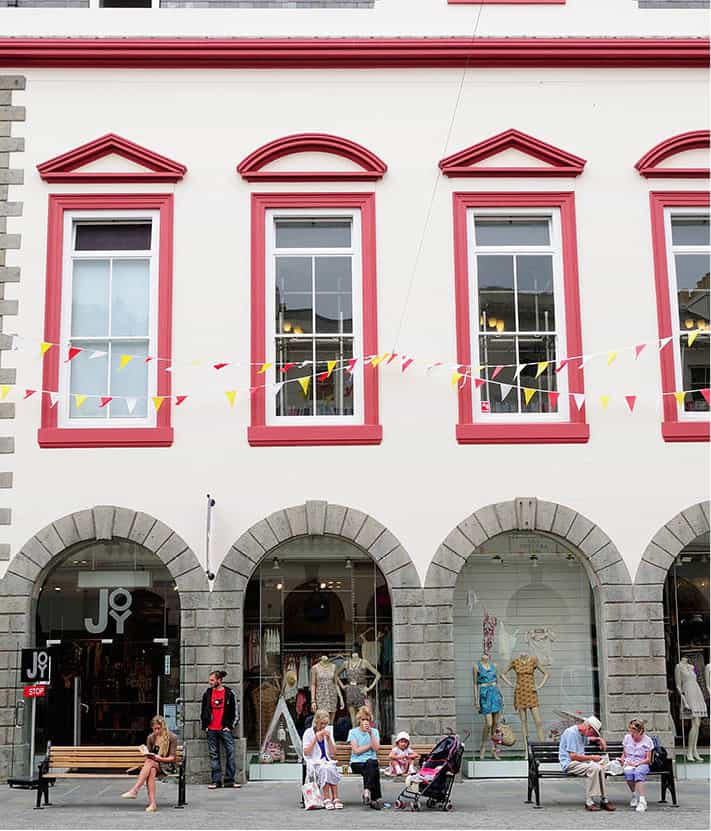
Market Square.
Mockford & Bonetti/Apa Publications
You will emerge at Market Square ) [map] where the old market is now a 21st-century shopping mall of high street names and local traders. Much of the facade has been preserved and the square is a pleasant spot to sit and watch the world go by. Produce from across the island is brought to the weekly Fresh Friday market (8.30am–2.30pm), while on Saturdays in summer the square is the venue for open-air concerts and drama.
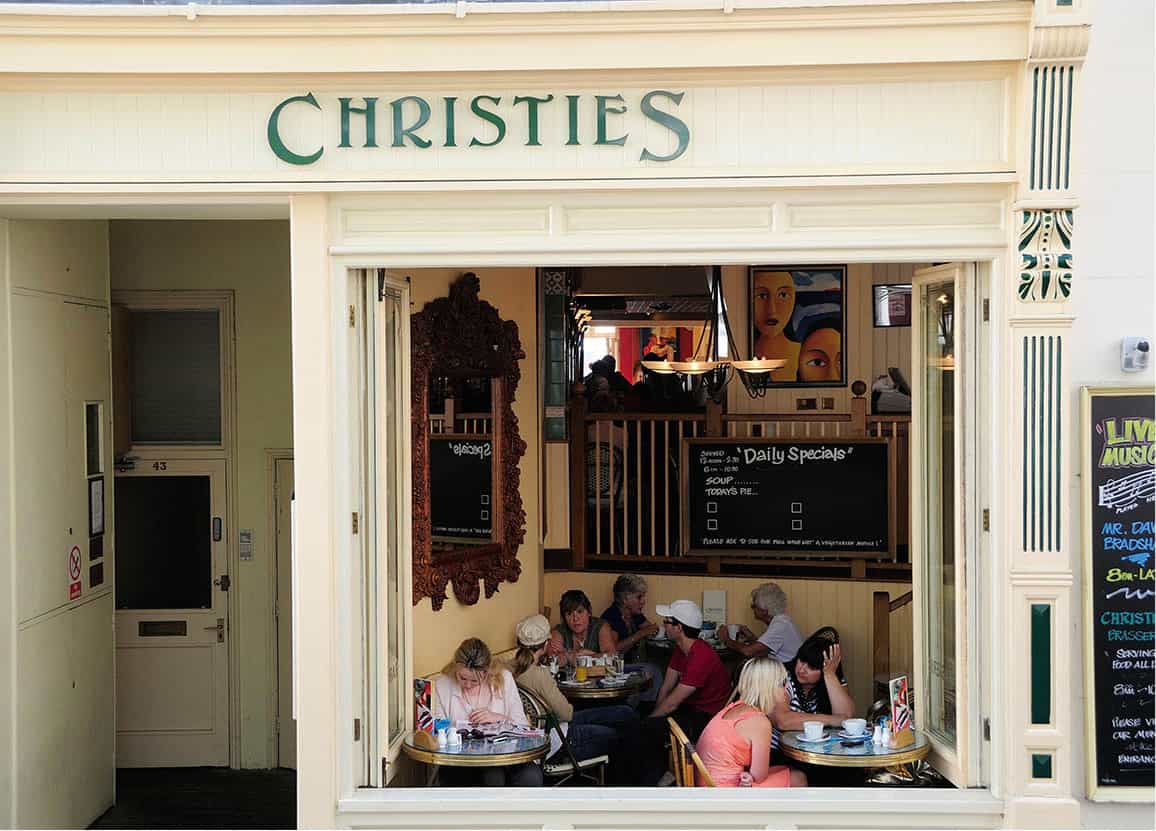
There are plenty of cafés to stop for breakfast or lunch.
Mockford & Bonetti/Apa Publications
Even if you aren’t a keen shopper, it’s worth exploring the maze of the Arcades, to the left as you emerge from Market Street, along with the High Street and its extension, Le Pollet ! [map] and Lower Pollet. Many of the shops along these streets have attractive Regency, Victorian and Edwardian shop fronts – and there are plenty of inviting cafés where you can stop for coffee or cakes.
Civic St Peter Port
At the junction of High Street and Le Pollet, Smith Street leads left and uphill towards the Royal Court, centre of island government and administration. Walking up Smith Street, do not miss the lace-like detailing of the ironwork decorating the facades of some of the shops and businesses that line the way.
Foodie events
Early July is a good time to try the best of Guernsey’s freshly caught seafood, while late autumn is the time for some real bargains, with dozens of eateries offering fixed-price menus from £10. The ‘Tennerfest’ fixed-price food festival runs for six weeks from October to mid-November throughout the Channel Islands. Country and farmers’ markets also sell local produce, such as Guernsey cheeses, home-made cakes, local honey, fish and meat, all year round.
At the top of the hill, to the left, is the sombre courthouse, in which the States of Deliberation, which governs the Bailiwick of Guernsey, held its first meetings in 1803. In the same building are the island’s courts – civil and criminal. They are located only a short step away from Guernsey’s main police station, which occupies the former workhouse, La Maison de Charité. To find it, turn around and go past the little garden at the top of Smith Street, then head straight across, down Hirzel Street. This will bring you to the gates of the former workhouse. On the gatehouse is a plaque showing a pelican pecking her breast to feed her young with her own blood, the traditional symbol of charitable self-sacrifice, and the 1742 date stone.

The facade of the Royal Court.
Mockford & Bonetti/Apa Publications
Turn left here and walk up Hospital Lane to emerge on St Julian’s Avenue. To the right is a War Memorial to Guernsey and Alderney officers and men killed in the Boer War; to the left, along College Street, is St James, a deconsecrated garrison church providing Guernsey with a versatile venue for concerts, drama, lectures and exhibitions. Part of the complex is the purpose-built Dorey Centre, housing the Guernsey Tapestry @ [map] (www.guernseytapestry.org.gg; April–Oct Mon–Sat 10am–4.30pm, Nov–March Thurs only 11am–4pm; charge). The display comprises 10 separate tapestries, each one representing a century of Guernsey’s history. These historically accurate and meticulously worked scenes were created by the 10 Guernsey parishes to mark the new millennium and each one bears the crest of the relevant parish. The stories in the panels are brought to life by an audio guide.

The historic Candie Gardens were established in 1894.
Mockford & Bonetti/Apa Publications
Across the road lies the neo-Gothic bulk of Elizabeth College, founded as a school in 1563, and named after Queen Elizabeth I, but rebuilt in the 1820s using proceeds from a special tax of a shilling on every gallon of spirits sold on the island. Having crossed the road, turn right for the peaceful Candie Gardens £ [map] (daily all year until dusk) in Candie Road. Once part of a private estate, the gardens were bequeathed to the islanders in 1871 and turned into a public park. On sunny days locals and visitors stretch out on the lawn and admire the wonderful views over the gardens and harbour. A pretty Victorian bandstand has been converted into an excellent café, where brass bands strike up on summer Sunday afternoons. At the top of the gardens stands a statue of Queen Victoria in full imperial regalia with orb and sceptre. This is diplomatically separated from a more flamboyant statue of her critic, Victor Hugo, which was given to Guernsey by the French Government in thanks for the hospitality shown by the island to Hugo during his exile.
Beau Séjour
Guernsey vies with Jersey for the highest sunshine totals in the British Isles. But rain can be a problem in springtime. This is the time to take the youngsters to the Beau Séjour Leisure Centre (www.beausejour.gg, open daily) on the hilltop above St Peter Port, to enjoy the 25m (82ft) swimming pool or separate learner pool; also tennis and badminton courts, and a crèche with activities for older children.
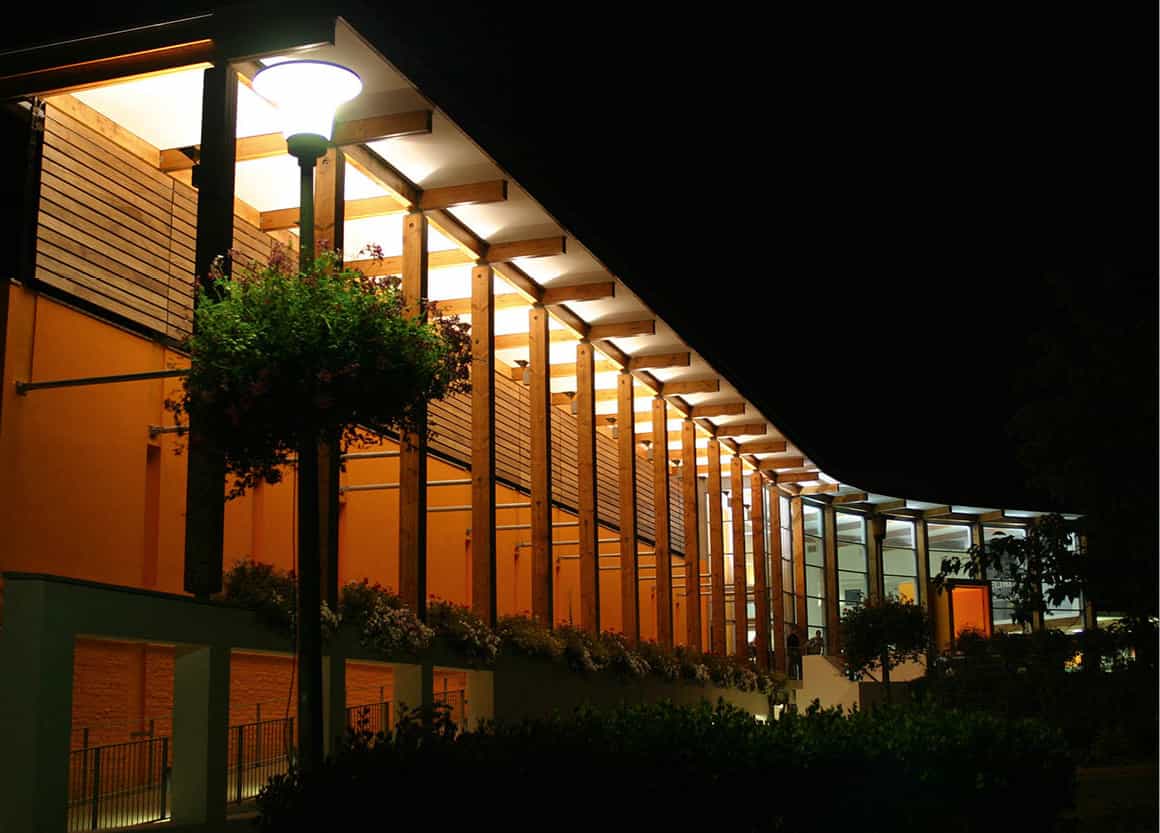
The Beau Séjour offers sports, theatre and musical events.
Visit Guernsey
Guernsey Museum at Candie
The Guernsey Museum at Candie $ [map] (www.museums.gov.gg; daily Feb–Dec 10am–4pm, Apr–Oct until 5pm; charge) is a venue for temporary exhibitions (see website for an ongoing programme throughout the year) but also has a permanent collection of archaeology, history, wildlife and art, some of which is shown on a rotating basis. Exhibits include Rodin’s bust of Victor Hugo (1883), wearing a most expressive frown and wild beard, and characterful sketches by Peter de Lièvre (1812–78) of island farmers and fishermen, giving an insight into life on the island in Victorian times. Little ones might prefer the Cabinet of Curiosities in the Discovery room or dressing up in old-fashioned clothes.
Eating Out
Balthazar
The Quay; tel: 01481-700 083 www.balthazar.gg, lunch and dinner.
A new addition to the St Peter Port culinary scene, this welcoming brasserie serves food sourced from local producers and farmers on the island. There’s also a Champagne-style bar with a separate bar menu. ££–£££
Da Nello
Le Pollet; tel: 01481-721 552; www.danello.gg; lunch and dinner.
A popular Italian restaurant with an inviting covered courtyard, serving a wide range of traditional pasta, seafood and meat dishes. ££–£££
Les Cotils; tel: 01481-724 624; www.lafregatehotel.com; lunch and dinner.
Outstanding, slightly formal restaurant with magical views of the harbour and outer islands. International cuisine using local products wherever possible. Regarded by many as the best food on the island. £££
Le Nautique
Quay Steps; tel: 01481-721 714; www.lenautiquerestaurant.co.uk; closed Sun.
One of the top seafood restaurants, with lovely views over the marina – if you are lucky enough to secure a window seat. Chef-proprietor Günter Botzenhart gives classical dishes a modern twist and his menu is constantly changing to make the most of produce in season. £££
Old Quarter
15 Mansell Street; tel: 01481-727 268; www.oldquarter.co.uk; closed Sun and lunch on Mon.
Good value no-frills food with an Irish twist (Paddy is the genial chef). The lunch and early dinner menus, at £11.95 and £14.95, are a bargain. £–££
Le Petit Bistro
56 Le Pollet; tel: 01481-725 055; www.petitbistro.co.uk; closed Sun and Mon.
Authentic French cuisine in atmospheric and very reasonably priced bistro. Specialities feature coq au vin, coquille St Jacques and frogs’ legs. Excellent-value set lunches and early-bird dinners. The adjoining Le Petit Café is open all day. £–££
Pier 17
Albert Pier; tel: 01481-720 823; www.pier17restaurant.com; closed Sun.
One of the island’s most popular restaurants with a contemporary setting and great views over the working harbour and Castle Cornet. Book well in advance. ££–£££
RED
61, The Pollet; tel: 01481-700 299; www.red.gg; closed Sat lunch and Sun.
A cool grill house and cocktail bar where top quality cuts of beef (Porterhouse and rib on the bone among them) are cooked on a charcoal grill. Non-carnivores are catered for with roast or grilled market fish, and vegetarians with the likes of goat’s cheese soufflé and gnocchi with asparagus and girolles. ££–£££
The Swan Inn
St Julian’s Avenue; tel: 01481-728 969; closed Mon.
This welcoming Victorian pub is a favourite for evening drinks and hearty helpings of home-made pies, burgers or beer-battered cod and chips. £
